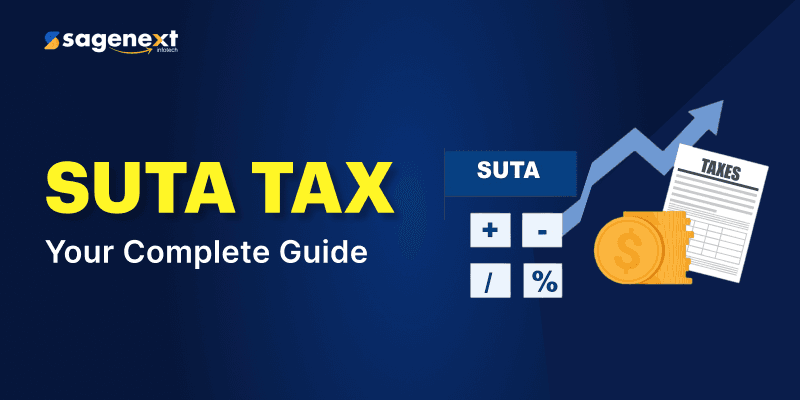
What is Suta Tax? (State Unemployment Tax) Everything You Should Know 2025
The State Unemployment Tax (SUTA Tax) is a state-level tax that employers are required to fund for unemployment benefits provided to employees or workers who lose their jobs and become unemployed. Every state in the United States has a SUTA tax mandate, but the names could differ from one state to another. For instance, in Florida, it is known as the reemployment tax. A specific rate contribution must be made to the SUTA tax fund, calculated using the method explained below.
In this blog post, we will be uncovering what SUTA tax is, how to calculate SUTA tax, the SUTA tax rate for 2025, and more. Let us cover the topic briefly and explore it further.
What is SUTA Tax?
SUTA tax is a payroll tax that employees are required to pay for the unemployment benefits of other workers. The tax is deposited directly into the state unemployment fund. In simple terms, whenever an employee loses their job, they will be eligible to receive unemployment benefits, which are funded by the SUTA (State Unemployment Tax Act) fund of every state in the United States. The actual meaning of the Suta tax is that financial relief is provided to those who are unemployed and actively seeking new employment. Remember, State Unemployment Tax (SUTA) is also referred to as State Unemployment Insurance (SUI); do not confuse the terms.
You should also be aware that SUTA tax is an additional tax to FUTA (Federal Unemployment Tax), which provides financial assistance to unemployed citizens in the USA. The SUTA, or SUI, tax rate varies from one state to another, but the rate companies pay is generally based on the number of unemployment claims they’ve had in the past. The funds collected from these taxes help unemployed workers or ex-employees bridge the gap until they find their next job.
SUTA tax varies by state and is determined based on the state’s SUTA rate. While calculating SUTA tax, several factors are taken into consideration. For example, the age of the company or business, the number of unemployed claims, and the turnover rate for that business. Did you know? Failing to contribute to the SUTA fund can result in legal consequences and a substantial fine for the employer.
Make Tax Season Easier — Move to the Cloud Today
Same Tax, Different Name: A Glimpse
| State Name | SUTA Tax Name as Per State |
| Florida | Reemployment Tax |
| Alaska | Employment Security Tax |
| Texas | Unemployment Tax Program |
| State Unemployment Insurance (SUI) or State Unemployment Tax (SUTA) | |
Difference Between SUTA Tax & FUTA Tax
| SUTA Tax (State Unemployment Tax) | FUTA Tax (Federal Unemployment Tax) |
| SUTA allows unemployed citizens benefits at the state level. However, FUTA also provides financial assistance to these states. | While FUTA is the federal-level tax fund for unemployed citizens, it also oversees the state-level unemployment fund requirements. During a high-unemployment situation, states can borrow funds from the FUTA. |
How to Calculate SUTA Tax?
SUTA tax is calculated based on several factors, including a certain percentage as prescribed in the wage base limit. Other factors for consideration include the business’s operating history, turnover rate, and the number of unemployment claims. SUTA rate is generally between 0 to 10%, depending on the above factors.
Example of How SUTA Tax is Calculated:
Take these into consideration:
| The Florida state wage base limit is $7000 | The new employer tax rate is 2.7% | |
For instance, say Michael has a retail business in Florida this year. Now, as per the wage base limit for Florida ($7,000), the amount Michael needs to pay would be calculated as $7,000 x 2.7% = $7,189. If we assume that his employee earns more than the base wage rate, in this case, Michael needs to pay $189 per employee per year to the SUTA fund. (He will continue paying the rate until, in case the state adjusts the rate.)
Keep in mind that every state has its own minimum base wage rate limit, and the calculation of the SUTA tax rate will differ from state to state.
2025 SUTA Rate as Per State (USA)
| State | Wage Base Limit | State | Wage Base Limit |
| Alabama | $8000 | Alaska | $51700 |
| Arizona | $8000 | Arkansas | $7000 |
| California | $7000 | California SDI | No limit as of now |
| Colorado | $27200 | Connecticut | $26100 |
| Delaware | $12500 | Columbian District | $9000 |
| Federal | $176100 | Florida | $7000 |
| Georgia | $9500 | Hawaii | $62000 |
| Idaho | $55300 | Illinois | $13916 |
| Indiana | $9500 | Lowa | $39500 |
| Kansas | $14000 | Kentucky | $11700 |
| Louisiana | $7700 | Maine | $12000 |
| Maryland | $8500 | Massachusetts | $15000 |
| Michigan | $9500 | Minnesota | $43000 |
| Mississippi | $14000 | Missouri | $9500 |
| Montana | $45100 | Nebraska | $9000 |
| Nevada | $41800 | New Hemisphere | $14000 |
| New Jersey | $43300 | New Jersey TDI EE | $165400 |
| New Mexico | $33200 | North Carolina | $32600 |
| North Dakota | $45100 | Ohio | $9000 |
| Oklahoma | $28200 | Oregon | $54300 |
| Pennsylvania | $10000 | Puerto Rico | $7000 |
| Rhode Island | $29800 | South Carolina | $14000 |
| South Dakota | $15000 | Tennessee | $7000 |
| Texas | $9000 | Utah | $48900 |
| Vermont | $14800 | Virgin Islands | $31100 |
| Virginia | $8000 | Washington | $72800 |
| West Virginia | $9500 | Wisconsin | $14000 |
| Wyoming | 32400 | NA | NA |
Who All Are Exempted from SUTA & FUTA?
- Employees or workers who quit their jobs are not eligible for unemployment benefits.
- If businesses or companies dismiss their employees and workers, then these employees/workers may be eligible for unemployment benefits. (If the employee is fired due to misconduct, then he/she will not receive the SUTA benefit.)
- If an employee is actively seeking a job and unable to find one, they may be eligible to claim the benefit of the SUTA tax rate.
Boost Your Tax Workflow — Host Your Software Today
Final Words
To summarize, the SUTA tax is designed to provide financial relief to unemployed workers or employees. Every business or company is required to deposit a specific SUTA tax rate into the state unemployment fund. The SUTA tax rate is determined based on the company’s age, the number of unemployment claims, and the rate of employee turnover. The SUTA rate typically ranges from 0% to 10% and is calculated based on the wage base limit for each state, as listed above. Please note that employers are legally obligated to contribute to the SUTA fund; failing to do so may result in penalties or action. SUTA & FUTA both play a role in unemployment fund contributions at the federal and state levels. Employees who voluntarily quit their jobs are not eligible for unemployment benefits.
For more on a similar topic, follow the Sagenext blog page now.
FAQs (Frequently Asked Questions)
What is the SUTA tax on my paycheck?
SUTA tax is not deducted from the employee’s paycheck. It is the responsibility of the employer to contribute in most states in the USA. However, a few states, such as Alaska, Pennsylvania & New Jersey, require minimal employee contributions to the SUTA fund.
Is the SUTA unemployment tax?
Yes, SUTA is a type of unemployment tax. SUTA is also referred to as SUO (State Unemployment Insurance).
Do employees pay SUTA tax?
No, only employers are required to pay SUTA tax; however, only three states, including Alaska, Pennsylvania, and New Jersey, also require employees to make a small contribution in addition to employers.
How to calculate SUTA tax in Florida?
Here is a breakdown:
SUTA tax rate for Florida is 2.7% and the Wage Base Limit for Florida is $7000.
So the employer would pay a SUTA tax as calculated. $7000 x 2.7% = $7189. So for every new employee, the employer will have to pay $189 per year. (Keep in mind that the employee has to earn over the wage base limit to get the benefit.)






